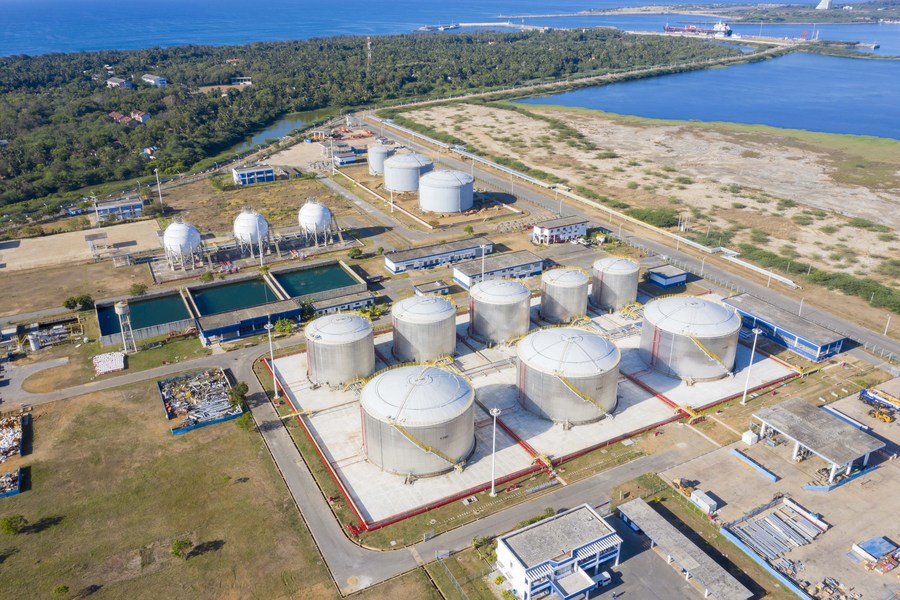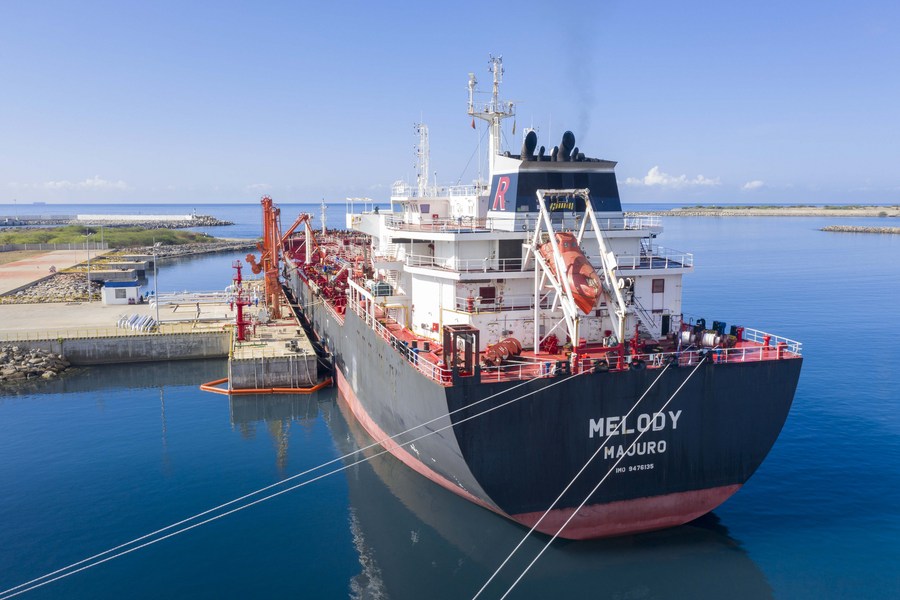
Aerial photo taken on April 6, 2020 shows the Marshall Islands-based Mt. Melody bunkering ship in operation at Hambantota International Port, Sri Lanka. (Photo by Liu Hongru/Xinhua)
"With a new administration in Washington, the truth about the widely, perhaps willfully, misunderstood case of Hambantota Port is long overdue," the authors wrote.
WASHINGTON, Feb. 8 (Xinhua) -- The narrative of Chinese "dept-trap diplomacy" is just a powerful, well-told lie, which wrongfully portrays China and the developing countries it deals with, two U.S. scholars have co-written.
The former U.S. administration was touting the fallacy of "debt-trap diplomacy," taking the Sri Lankan port of Hambantota as the prime example to warn against China's strategic use of debts, according to the article co-authored by Deborah Brautigam, an international political economy professor at Johns Hopkins University, and Meg Rithmire, an associate professor at Harvard Business School.
However, a research of the co-authors showed that Chinese lenders are willing to restructure the terms of existing loans and have never actually seized an asset from any country, much less the port of Hambantota, according to the piece published on the Atlantic on Saturday, which clarifies the background and timeline of the Hambantota port project.
Armed with a feasibility report developed by the Danish engineering firm Ramboll in 2006, the Sri Lankan government had approached the United States and India for the port project financing but was rejected by both.

Aerial photo taken on April 6, 2020 shows oil tank area at Hambantota International Port, Sri Lanka. (Photo by Liu Hongru/Xinhua)
In 2007, with China Harbour Engineering Company lobbying hard, the Export-Import Bank of China offered a more than 300-million-U.S.-dollar, 15-year commercial loan for the project, and the group won the contract. At that time, the long civil war in Sri Lanka was still ongoing.
The writers quoted Saliya Wickramasuriya, former chairman of the Sri Lanka Ports Authority, as saying, "to get commercial loans as large as 300 million dollars during the war was not easy."
Additionally, there was also never a default as rumors say, according to the writers, although the port was losing money by 2014. Actually, "Colombo arranged a bailout from the International Monetary Fund, and decided to raise much-needed dollars by leasing out the underperforming Hambantota Port to an experienced company," they explained.
Sri Lanka chose China Merchants Port Holdings, making it the majority shareholder with a 99-year lease, and used 1.12 billion dollars infusion to bolster its foreign reserves, but not to pay off debts, according to the piece.

Aerial photo taken on April 6, 2020 shows the Marshall Islands-based Mt. Melody bunkering ship in operation at Hambantota International Port, Sri Lanka. (Photo by Liu Hongru/Xinhua)
"With a new administration in Washington, the truth about the widely, perhaps willfully, misunderstood case of Hambantota Port is long overdue," they wrote.
Meanwhile, on the other side of the debt-trap myth are debtor countries, which are also offended by the narrative that they could be easily inveigled. Speaking to the co-authors on condition of anonymity, a Malaysian politician wondered if the U.S. State Department could tell difference between campaign rhetoric against oppositions and the truth.
The events tied to the Sri Lankan port revealed how the world is changing, the scholars said. "China and other countries are becoming more sophisticated in bargaining with one another. And it would be a shame if the U.S. fails to learn alongside them." ■




